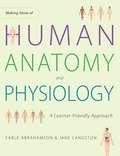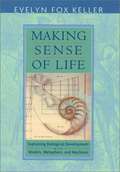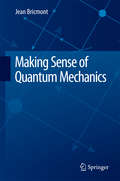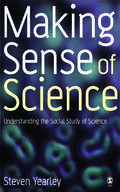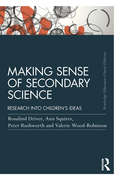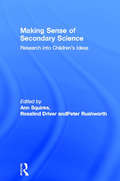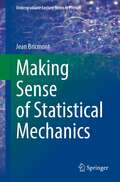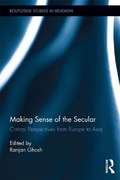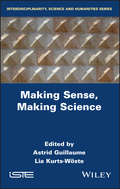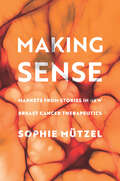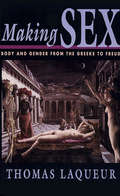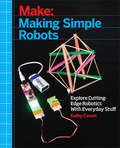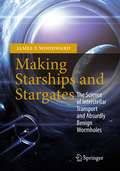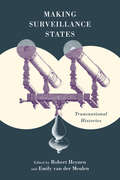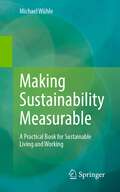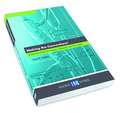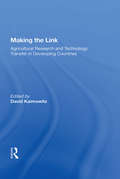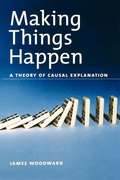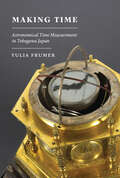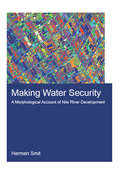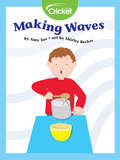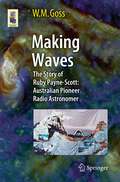- Table View
- List View
Making Sense of Human Anatomy and Physiology: A Learner-Friendly Approach
by Earle Abrahamson Jane LangstonDesigned to be user-friendly and informative for both students and teachers, this book provides a road map for understanding problems and issues that arise in the study of anatomy and physiology. Students will find tips to develop specific study skills that lead to maximum understanding and retention. They will learn strategies not only for passing an examination or assessment, but also for permanently retaining the fundamental building blocks of anatomical study and application. For the teacher and educator, the book provides useful insight into practical and effective assessment techniques, explores the subject matter from a learning approach perspective, and considers different methods of teaching to best to convey the message and meaning of anatomy and physiology. Supported by clear diagrams and illustrations, this is a key text for teachers who want a useful toolbox of creative techniques and ideas that will enhance the learning experience. In addition to the wealth of information it provides, Making Sense of Human Anatomy and Physiology sets in place a bedrock of learning skills for future study, regardless of the subject. Students of beauty therapies, holistic and complementary therapies, and fitness professionals--yoga teachers, personal trainers, sports coaches, and dance teachers--will gain not only a basic understanding of anatomy and physiology, but also the skills to learn such a subject. Allied professionals in nursing, biomedical science, dentistry, occupational therapy, physiotherapy, midwifery, zoology, biology and veterinary science will also find this book an invaluable resource. The final chapters offer suggestions for the further exploration of concepts, assessment, learning activities, and applications.
Making Sense of Life: Explaining Biological Development with Models, Metaphors, and Machines
by Evelyn Fox KellerA history of the diverse and changing nature of biological explanation in a particularly charged field, "Making Sense of Life" draws readers attention to the temporal, disciplinary, and cultural components of what biologists mean, and what they understand, when they propose to explain life. Illustrations. Copyright © Libri GmbH. All rights reserved.
Making Sense of Quantum Mechanics
by Jean BricmontThis book explains, in simple terms, with a minimum of mathematics, why things can appear to be in two places at the same time, why correlations between simultaneous events occurring far apart cannot be explained by local mechanisms, and why, nevertheless, the quantum theory can be understood in terms of matter in motion. No need to worry, as some people do, whether a cat can be both dead and alive, whether the moon is there when nobody looks at it, or whether quantum systems need an observer to acquire definite properties. The author's inimitable and even humorous style makes the book a pleasure to read while bringing a new clarity to many of the longstanding puzzles of quantum physics.
Making Sense of Science: Separating Substance from Spain
by Cornelia DeanCornelia Dean draws on her 30 years as a science journalist with the New York Times to expose the flawed reasoning and knowledge gaps that handicap readers when they try to make sense of science. She calls attention to conflicts of interest in research and the price society pays when science journalism declines and funding dries up.
Making Sense of Science: Understanding the Social Study of Science
by Steven Yearley`Fluid, readable and accessible ... I found the overall quality of the book to be excellent. It provides an overview of major (and preceding) developments in the field of science studies. It examines landmark works, authors, concepts and approaches ... I will certainly use this book as one of the course texts' Eileen Crist, Associate Professor, Science & Technology in Society, Virginia Tech Science is at the heart of contemporary society and is therefore central to the social sciences. Yet science studies has often encountered resistance from social scientists. This book attempts to remedy this by giving the most extensive, thorough and best argued account of the field and explaining to social scientists why science matters to them. This is a landmark book that demystifies science studies and successfully bridges the divide between social theory and the sociology of science. Illustrated with relevant, illuminating examples, it provides the ideal guide to science studies and social theory.
Making Sense of Secondary Science: Research into children's ideas
by Rosalind Driver Peter Rushworth Ann Squires Valerie Wood-RobinsonWhat ideas do children hold about the natural world? How do these ideas affect their learning of science? Young learners bring to the classroom knowledge and ideas about many aspects of the natural world constructed from their experiences of education and from outside school. These ideas contribute to subsequent learning, and research has shown that teaching of science is unlikely to be effective unless it takes learners’ perspectives into account. Making Sense of Secondary Science provides a concise, accessible summary of international research into learners’ ideas about science, presenting evidence-based insight into the conceptions that learners hold, before and even despite teaching. With expert summaries from across the science domains, it covers research findings from life and living processes, materials and their properties and physical processes This classic text is essential reading for all trainee secondary, elementary and primary school science teachers, as well as those researching the science curriculum and science methods, who want to deepen their understanding of how learners think and to use these insights to inform teaching strategies. It also provides a baseline for researchers wishing to investigate contemporary influences on children’s ideas and to study the persistence of these conceptions. Both components of Making Sense of Secondary Science – this book and the accompanying teacher’s resource file, Making Sense of Secondary Science: Support materials for teachers - were developed as a result of a collaborative project between Leeds City Council Department of Education and the Children’s Learning in Science Research Group at the University of Leeds, UK.
Making Sense of Secondary Science: Research into children’s ideas
by Rosalind Driver Peter Rushworth Ann Squires Valerie Wood-RobinsonWhen children begin secondary school they already have knowledge and ideas about many aspects of the natural world from their experiences both in primary classes and outside school. These ideas, right or wrong, form the basis of all they subsequently learn. Research has shown that teaching is unlikely to be effective unless it takes into account the position from which the learner starts. Making Sense of Secondary Science provides a concise and accessible summary of the research that has been done internationally in this area. The research findings are arranged in three main sections: * life and living processes* materials and their properties* physical processes. Full bibliographies in each section allow interested readers to pursue the themes further. Much of this material has hitherto been available only in limited circulation specialist journals or in unpublished research. Its publication in this convenient form will be welcomed by all researchers in science education and by practicing science teachers continuing their professional development, who want to deepen their understanding of how their children think and learn.
Making Sense of Statistical Mechanics (Undergraduate Lecture Notes in Physics)
by Jean BricmontMany people, including physicists, are confused about what the Second Law of thermodynamics really means, about how it relates to the arrow of time, and about whether it can be derived from classical mechanics. They also wonder what entropy really is: Is it all about information? But, if so, then, what is its relation to fluxes of heat?One might ask similar questions about probabilities: Do they express subjective judgments by us, humans, or do they reflect facts about the world, i.e. frequencies. And what notion of probability is used in the natural sciences, in particular statistical mechanics?This book addresses all of these questions in the clear and pedagogical style for which the author is known. Although valuable as accompaniment to an undergraduate course on statistical mechanics or thermodynamics, it is not a standard course book. Instead it addresses both the essentials and the many subtle questions that are usually brushed under the carpet in such courses. As one of the most lucid accounts of the above questions, it provides enlightening reading for all those seeking answers, including students, lecturers, researchers and philosophers of science.
Making Sense of the Secular: Critical Perspectives from Europe to Asia (Routledge Studies in Religion #24)
by Ranjan GhoshThis book offers a wide range of critical perspectives on how secularism unfolds and has been made sense of across Europe and Asia. The book evaluates secularism as it exists today – its formations and discontents within contemporary discourses of power, terror, religion and cosmopolitanism – and the focus on these two continents gives critical attention to recent political and cultural developments where secularism and multiculturalism have impinged in deeply problematical ways, raising bristling ideological debates within the functioning of modern state bureaucracies. Examining issues as controversial as the state of Islam in Europe and China’s encounters with religion, secularism, and modernization provides incisive and broader perspectives on how we negotiate secularism within the contemporary threats of terrorism and other forms of fundamentalism and state-politics. However, amidst the discussions of various versions of secularism in different countries and cultural contexts, this book also raises several other issues relevant to the antitheocratic and theocratic alike, such as: Is secularism is merely a nonreligious establishment? Is secularism a kind of cultural war? How is it related to "terror"? The book at once makes sense of secularism across cultural, religious, and national borders and puts several relevant issues on the anvil for further investigations and understanding.
Making Sense, Making Science
by Astrid Guillaume Lia Kurts-WösteThis book demonstrates the federative power of the methodology of the sciences of culture by exploiting its critical, historical, and comparative principles to address both cultural objects and disciplines that report on them. Scientific activity is rethought in its dimension of interpretative act responsible for both the human and the non-human. This book fills a gap by reconnecting in an innovative and original way the scientific, artistic and ethico-political spheres.
Making Sense: Markets from Stories in New Breast Cancer Therapeutics (Culture and Economic Life)
by Sophie MützelBreast cancer is one of the most commonly diagnosed cancers and a leading cause of death for women worldwide. With advances in molecular engineering in the 1980s, hopes began to rise that a non-toxic and non-invasive treatment for breast cancer could be developed. These hopes were stoked by the researchers, biotech companies, and analysts who worked to make sense of the uncertainties during product development. In Making Sense Sophie Mützel traces this emergence of "innovative breast cancer therapeutics" from the late 1980s up to 2010, through the lens of the narratives of the involved actors. Combining theories of economic and cultural sociology, Mützel shows how stories are integral for the emergence of new markets; stories of the future create a market of expectations prior to any existing products; stories also help to create categories on what such a new market and its products are about. Making Sense uses thousands of press statements, media reports, scientific reports, and financial and industry analyses, and combines qualitative and large-scale computational text analyses, to illustrate these mechanisms, presenting a fresh view of how life-prolonging innovations can be turned into market products.
Making Sex: Body and Gender from the Greeks to Freud
by Thomas LaqueurThis is a book about the making and unmaking of sex over the centuries. It tells the astonishing story of sex in the West from the ancients to the moderns in a precise account of developments in reproductive anatomy and physiology. We cannot fail to recognize the players in Thomas Laqueur’s story—the human sexual organs and pleasures, food, blood, semen, egg, sperm—but we will be amazed at the plots into which they have been woven by scientists, political activists, literary figures, and theorists of every stripe. <P><P> Laqueur begins with the question of why, in the late eighteenth century, woman’s orgasm came to be regarded as irrelevant to conception, and he then proceeds to retrace the dramatic changes in Western views of sexual characteristics over two millennia. Along the way, two “masterplots” emerge. In the one-sex story, woman is an imperfect version of man, and her anatomy and physiology are construed accordingly: the vagina is seen as an interior penis, the womb as a scrotum, the ovaries as testicles. The body is thus a representation, not the foundation, of social gender. The second plot tends to dominate post-Enlightenment thinking while the one-sex model is firmly rooted in classical learning. The two-sex story says that the body determines gender differences, that woman is the opposite of man with incommensurably different organs, functions, and feelings. The two plots overlap; neither ever holds a monopoly. Science may establish many new facts, but even so, Laqueur argues, science was only providing a new way of speaking, a rhetoric and not a key to female liberation or to social progress. Making Sex ends with Freud, who denied the neurological evidence to insist that, as a girl becomes a woman, the locus of her sexual pleasure shifts from the clitoris to the vagina; she becomes what culture demands despite, not because of, the body. Turning Freud’s famous dictum around, Laqueur posits that destiny is anatomy. Sex, in other words, is an artifice. <P><P> This is a powerful story, written with verve and a keen sense of telling detail (be it technically rigorous or scabrously fanciful). Making Sex will stimulate thought, whether argument or surprised agreement, in a wide range of readers.
Making Simple Robots
by Kathy CeceriMaking Simple Robots is based on one idea: Anybody can build a robot! That includes kids, English majors, school teachers, and grandparents. If you can knit, sew, or fold a flat piece of paper into a box, you can build a no-tech robotic part. If you can use a hot glue gun, you can learn to solder basic electronics into a low-tech robot that reacts to its environment. And if you can figure out how to use the apps on your smart phone, you can learn enough programming to communicate with a simple robot.Written in language that non-engineers can understand, Making Simple Robots helps beginners move beyond basic craft skills and materials to the latest products and tools being used by artists and inventors. Find out how to animate folded paper origami, design a versatile robot wheel-leg for 3D printing, or program a rag doll to blink its cyborg eye. Each project includes step-by-step directions as well as clear diagrams and photographs. And every chapter offers suggestions for modifying and expanding the projects, so that you can return to the projects again and again as your skill set grows.
Making Space: How the Brain Knows Where Things Are
by Jennifer M. GrohKnowing where things are seems effortless. Yet our brains devote tremendous power to figuring out simple details about spatial relationships. Jennifer Groh traces this mental detective work to show how the brain creates our sense of location, and makes the case that the brain's systems for thinking about space may be the systems of thought itself.
Making Starships and Stargates
by James F. WoodwardTo create the exotic materials and technologies needed to make stargates and warp drives is the holy grail of advanced propulsion. A less ambitious, but nonetheless revolutionary, goal is finding a way to accelerate a spaceship without having to lug along a gargantuan reservoir of fuel that you blow out a tailpipe. Tethers and solar sails are conventional realizations of the basic idea. There may now be a way to achieve these lofty objectives. "Making Starships and Stargates" will have three parts. The first will deal with information about the theories of relativity needed to understand the predictions of the effects that make possible the "propulsion" techniques, and an explanation of those techniques. The second will deal with experimental investigations into the feasibility of the predicted effects; that is, do the effects exist and can they be applied to propulsion? The third part of the book - the most speculative - will examine the question: what physics is needed if we are to make wormholes and warp drives? Is such physics plausible? And how might we go about actually building such devices? This book pulls all of that material together from various sources, updates and revises it, and presents it in a coherent form so that those interested will be able to find everything of relevance all in one place.
Making Surveillance States: Transnational Histories
Making Surveillance States: Transnational Histories opens up new and exciting perspectives on how systems of state surveillance developed over the nineteenth and twentieth centuries. Taking a transnational approach, the book challenges us to rethink the presumed novelty of contemporary surveillance practices, while developing critical analyses of the ways in which state surveillance has profoundly shaped the emergence of contemporary societies. Contributors engage with a range of surveillance practices, including medical and disease surveillance, systems of documentation and identification, and policing and security. These approaches enable us to understand how surveillance has underpinned the emergence of modern states; sustained systems of state security; enabled practices of colonial rule; perpetuated racist and gendered forms of identification and classification; regulated and policed migration; shaped the eugenically inflected medicalization of disability and sexuality; and contained dissent. While surveillance is thus bound up with complex relations of power, it is also contested. Emerging from the book is a sense of how state actors understood and legitimized their own surveillance practices, as well as how these practices have been implemented in different times and places. At the same time, contributors explore the myriad ways in which these systems of surveillance have been resisted, challenged, and subverted.
Making Sustainability Measurable: A Practical Book for Sustainable Living and Working
by Michael WühleMaking something measurable means being able to control it Sustainability is a term with a wealth of meanings and many possible misinterpretations. Yet sustainability can be a powerful and effective tool to guide our practical actions and simplify complicated decisions. Sustainability can save costs and stabilize any organization and company. It protects the climate and the environment and leads all people into a good future. The non-fiction book "Making Sustainability Measurable" is a practical guide on how methods and instruments of sustainability can be used successfully - be it in professional life or in private and voluntary engagement. The book not only provides the interested layperson with a comprehensive overview of the central aspects of sustainability management, it also offers practitioners important decision-making aids and tips for implementation. The easy-to-understand style conveys all the essential contents of the topic of sustainability even to newcomers. Whether you have previous knowledge or not - with the many immediately implementable "best practices", the book offers a lot of practical application possibilities. The appendices contain unrestricted tools from the author's practice for the introduction of successful sustainability management.
Making The Link: Agricultural Research And Technology Transfer In Developing Countries
by David KaimowitzThis book is about International Service for National Agricultural Research's (ISNAR) study to identify key factors that influenced the effectiveness and efficiency of links between research and technology transfer. It recommends ways to improve these links and reflects the progress made till date.
Making Things Happen: A Theory Of Causal Explanation
by James WoodwardWoodward's long awaited book is an attempt to construct a comprehensive account of causation explanation that applies to a wide variety of causal and explanatory claims in different areas of science and everyday life. The book engages some of the relevant literature from other disciplines, as Woodward weaves together examples, counterexamples, criticisms, defenses, objections, and replies into a convincing defense of the core of his theory, which is that we can analyze causation by appeal to the notion of manipulation.
Making Time on Mars (Inside Technology)
by Zara MirmalekAn examination of how the daily work of NASA's Mars Exploration Rovers was organized across three sites on two planets using local Mars time.In 2004, mission scientists and engineers working with NASA's Mars Exploration Rovers (MER) remotely operated two robots at different sites on Mars for ninety consecutive days. An unusual feature of this successful mission was that it operated on Mars time—the daily work was organized across three sites on two planets according to two Martian time zones. In Making Time on Mars, Zara Mirmalek shows that this involved more than a resetting of wristwatches; the team's struggle to synchronize with Mars time involved technological and communication breakdowns, informal workarounds, and extra work to support the technology that was intended to support people. Her account of how NASA created an entirely new temporality for the MER mission offers insights about the assumptions behind the organizational relationship between clock time and work.Mirmalek, herself a member of the mission team, offers an insider's view of the MER workplace and community. She describes the discord among MER's multiple temporalities and examines issues of professional identity that helped shape the experience of working according to Mars time. Considering time and work relationships through a multidisciplinary lens, Mirmalek shows how contemporary and historical human–technology relationships inform assumptions about the unalterability of clock time. She argues that the organizational connection between clock time and work, although still operational, is outdated.
Making Time: Astronomical Time Measurement in Tokugawa Japan (Studies of the Weatherhead East Asian Institute)
by Yulia FrumerWhat is time made of? We might balk at such a question, and reply that time is not made of anything—it is an abstract and universal phenomenon. In Making Time, Yulia Frumer upends this assumption, using changes in the conceptualization of time in Japan to show that humans perceive time as constructed and concrete. In the mid-sixteenth century, when the first mechanical clocks arrived in Japan from Europe, the Japanese found them interesting but useless, because they failed to display time in units that changed their length with the seasons, as was customary in Japan at the time. In 1873, however, the Japanese government adopted the Western equal-hour system as well as Western clocks. Given that Japan carried out this reform during a period of rapid industrial development, it would be easy to assume that time consciousness is inherent to the equal-hour system and a modern lifestyle, but Making Time suggests that punctuality and time-consciousness are equally possible in a society regulated by a variable-hour system, arguing that this reform occurred because the equal-hour system better reflected a new conception of time — as abstract and universal—which had been developed in Japan by a narrow circle of astronomers, who began seeing time differently as a result of their measurement and calculation practices. Over the course of a few short decades this new way of conceptualizing time spread, gradually becoming the only recognized way of treating time.
Making Water Security: A Morphological Account of Nile River Development (IHE Delft PhD Thesis Series)
by Hermen SmitThis book examines Nile water security through the morphology of the river: it uses the always changing form of the river as a theoretical and empirical device to map and understand how infrastructures and discourses dynamically interact with the Nile. By bringing a history of two centuries of dam development on the Nile in relation with the drainage of a hill slope in Ethiopia on the one hand and irrigation reform in Sudan on the other, the author shows how the scales, units and ‘populations’ figuring in projects to securitize the river emerge through the rearrangement of its water and sediments. The analysis of ‘Making water security’ is more than yet another story of how modern projects of water security have legitimized often violent dispossessions of Nile land and water. It shows how no water user is confined by the roles assigned by project engineers and planners. As ongoing modern ‘development’ of the river reduces the prospects for new large diversions of water, the targeted subjects of development and modernization make use of newly opened spaces to carve out their own projects. They creatively mobilize old irrigation and drainage infrastructures in ways that escape the universal logic of water security.
Making Waves
by Amy TaoTry these experiments to learn how sound waves travel through the air to make your eardrums vibrate!
Making Waves: Australian Pioneer Radio Astronomer
by M GossThis book is an abbreviated, partly re-written version of "Under the Radar - The First Woman in Radio Astronomy: Ruby Payne-Scott." It addresses a general readership interested in historical and sociological aspects of astronomy and presents the biography of Ruby Payne-Scott (1912 - 1981). As the first female radio astronomer (and one of the first people in the world to consider radio astronomy), she made classic contributions to solar radio physics. She also played a major role in the design of the Australian government's Council for Scientific and Industrial Research radars, which were in turn of vital importance in the Southwest Pacific Theatre in World War II. These radars were used by military personnel from Australia, the United States and New Zealand. From a sociological perspective, her career offers many examples of the perils of being a female academic in the first half of the 20th century. Written in an engaging style and complemented by many historical photographs, this book offers fascinating insights into the beginnings of radio astronomy and the role of a pioneering woman in astronomy. To set the scene, the first colourfully illustrated chapter presents an overview of solar astrophysics and the tools of the radio astronomer. From the reviews of "Under the Radar": "This is a beautifully-researched, copiously-illustrated and well-written book that tells us much more than the life of one amazing female radio astronomer. It also provides a profile on radar developments during WWII and on Australia's pre-eminent place in solar radio astronomy in the years following WWII. Under the Radar is compelling reading, and if you have taken the time to read right through this review then it certainly belongs on your bookshelf!" (Wayne Orchiston, Journal of Astronomical History and Heritage, March, 2010)
